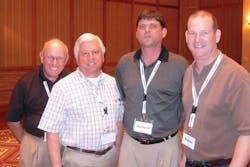During the recently completed Independent Tire Dealers Group (ITDG) meeting in Phoenix, Ariz., Modern Tire Dealer had the opportunity to sit down with four ITDG members for a round table discussion about current issues facing tire dealers.
Panel members were Robert (Bob) Slagle, owner of S&S Tire & Auto Service Center in Peoria, Ariz.; Lionel Pires, owner of Tulare Firestone in Tulare, Calif.; Robert Huebert, owner of Lee’s Tire in Reedley, Calif.; and Richard Howard, president of Bruce’s Tire Inc., in Fremont, Calif.
What is your biggest concern as a tire dealer right now?
Slagle: For us, it’s the price of oil/fuel. The rising cost is lowering the miles driven, which greatly impacts our business.
Pires: It’s the inventory shortages from major suppliers. It looks like they may not improve prior to the end of the year. This allows more off-shore products to come into this country. Once those doors are open, the flow will continue to come.
Huebert: Supply is the big issue this spring. There are back orders, and we see tires that are available one day are gone the next.
Howard: Employee benefits are my biggest concern because of the rapidly escalating expense of them.
Since supply was mentioned by several of you, what are you doing about it?
Slagle: We’ve been raising our stocking level. We also are buying more inventory because we think tire prices will continue to rise. The shortage is across all product segments as far as we can see.
Pires: We’ve increased our inventory by 50% in order to have product to sell. Currently, we still have some holes and must sell off-branded products. Most of these products have been on back order for more than six months. Ag tires and medium truck tires are the segments with the most serious shortages.
Huebert: As with the others, we’re looking very closely at our inventory levels and doing so far more frequently than normal. We’re not seeing one specific segment that is short; it’s just all over the board.
Howard: Supply has been tight with us in all segments. We have been forced to purchase based on size, not necessarily by manufacturer.
What are your other major concerns?
Slagle: It’s the possibility of inflation. We have added huge amounts of government debt over the past 10 years. Unless we ask the government to do less for us, taxes will be increased. Health care costs are another concern. We pay a major portion of our employees’ medical care. The amount has risen drastically, and I don’t see anything on the horizon that will reduce it.
Pires: Pricing from high crude costs and the manipulation of rubber pricing have created price increases never seen in the last 30 years. This has created the desire from many dealers to sell cheap in order to help their cash flow by moving product in order to pay their bills.
Huebert: I see increasing government regulations taxing valuable time. Tire costs are rising and our customers are looking at new ways to save.
Howard: The other dealers have already pretty well mentioned my other major concerns.
What impact are soaring gasoline/oil prices having on your business?
Slagle: In a random survey I saw this week, 62.5% of the respondents said they are changing their driving habits. Our consumer business is flat. Dollars are higher but not units.
Pires: We have had to adjust our budgets to offset these problems. Commercial salesmen are constantly reminded to drive less and purchase fuel at the least cost. It has also affected consumer and commercial tire purchases. Both don’t have the budget to purchase high-end products.
Huebert: Not only have our expenses increased — delivery, service, etc. — but our customers’ expenses have increased, too.
Howard: We’ve seen very little impact.
How are you handling on-going price increases?
Slagle: Most consumers are aware of escalating tire prices. We try hard to be competitive, and our competition has the same issues we do.
Pires: Consumers in both retail and commercial are doing more price checking because some of them really don’t believe the reasons behind the increases could cause such a large increase.
Huebert: Most consumers who haven’t purchased tires in a few years have sticker shock. We’re seeing much resistance to the increases. Inquiries about used tires are way up!
Howard: We find our salespeople need to spend the extra time to educate the consumer as to why the prices are up. Once explained, they normally understand.
[PAGEBREAK]
What impact have large distributors had on your business?
Slagle: Whenever possible, we buy directly from tire manufacturers. With the proliferation of sizes, we cannot have every tire in stock that consumers want. Distributors help us with those situations.
Pires: As in the past, they operate on low (margins) and survive on year-end bonuses. While some have gone out of business or sold, the big get bigger!
Huebert: Good, in that there is another source to go to for product, but bad, in that sometimes we perceive them as competition.
Howard: With the back order situation from our direct programs, we are fortunate to have a good relationship with the large distributors.
Are your customers asking for low-rolling resistance tires?
Slagle: No. They have not been educated about rolling resistance.
Pires: There is very little demand for (consumer) tires that are low-rolling resistant. There is some demand for medium truck tires.
Huebert: No.
Howard: Very few.
How important is online training to you?
Slagle: We have used online training for years. The more informed we are about a product, the less likely we are to lose a sale. MAST (Michelin Americas Small Tires) probably has the best online training that we have seen.
Pires: It will be a factor in the future. We currently do little online training. Most training comes from in-house training and the Tire Industry Association (TIA).
Huebert: We have used some online training and I can see even more in the future. We currently are receiving training from suppliers, vendors and associations in a wide variety of areas.
Howard: It is important. However, I prefer the old-fashioned way — face to face.
Are you a member of TIA, and if yes, why?
Slagle: We belong to TIA because they have excellent training for our tire technicians, and we regularly attend the SEMA (Specialty Equipment Market Association) Show.
Pires: We are a member of TIA primarily for the TIA training. We have our own in-house TIA certified trainers.
Huebert: Yes, we are members. TIA provides a national voice for tire dealers. They can be the eyes and ears on national and state issues that affect our industry, and they provide data and tools to members that are necessary to succeed in today’s competitive market.
Howard: ITDG is a member, but Bruce’s Tire is not.
What are your top three reasons for being an ITDG member?
Slagle: Originally, we joined ITDG to lower our acquisition costs for tires so we could compete. Since then, we have become a stockholder, and each March we receive a nice volume bonus and dividend check. Our top three reasons for being a member are: 1. ITDG lowers our buying costs; 2. we have many partners who I can exchange views with; and 3. we have a “captive” insurance company for workers’ compensation. Since joining, through their aggressive risk management, we have reduced our X Mod (experience mod) from 129 to 98. That has lowered our costs.
Pires: I belong to ITDG because: 1. most importantly, it gives us a good buying price by using the group’s potential buying price, which as a single dealer we would not get from the manufacturers. 2. The insurance group is a well-organized company and it has a great preventative safety program. It has been one of the reasons that my experience mod has gone down. Their periodic safety inspections are a great asset. More importantly is the manner that they are now closing injury cases within a very reasonable amount of time. This helps save the group money and as a dealer it helps keep our costs down. This insurance group is second-to-none. 3. Being an investor in the group, the leasing company and the insurance group have shown to be good investments. Year-end dividends have been more than expected.
Huebert: We joined for product and pricing. ITDG provides: 1. consistent workers’ comp coverage; 2. a network of dealers to discuss issues; and 3. programs and products that have a positive effect on our bottom line.
Howard: ITDG is extremely important to our bottom line. The top three reasons for being a member are: 1. captive insurance company; 2. being able to exchange ideas amongst peers; and 3. the ability to remain an independent tire dealer and still purchase from so many different suppliers competitively.
Meet the Independent Tire Dealers Group panelists
• Robert (Bob) Slagle, owner of S&S Tire & Auto Service Center in Peoria, Ariz. The company has three retail locations along with an e-commerce site for specialty tires. Slagle has run the company since 1976. Company Web sites: www.tiresaz.com and www.specialtytiresusa.com.
• Lionel Pires, owner of Tulare Firestone in Tulare, Calif. The company has 10 facilities and is also one of the largest distributors of agricultural tires in the western United States. The Pires family became partners in the company in 1975, and in 1983 took complete control of it. Company Web site: www.tftire.com.
• Robert Huebert, owner of Lee’s Tire in Reedley, Calif. The company has three locations. One of the locations is retail only, one is retail/commercial and one is commercial only. The company does some wholesale business and was founded in 1949. Company Web site: www.leesservice.com.
• Richard Howard, president of Bruce’s Tire Inc., in Fremont, Calif. The company has six retail/commercial locations around the Bay area of Northern California. Richard and his brother, Dwain, run the family business that was established in 1936. Howard also is chairman of the board of ITDG. Company Web site: www.brucestire.com.
About the Author
Greg Smith
Publisher
A 46-year tire industry veteran, Greg Smith is the publisher of Modern Tire Dealer. He also is the publisher of National Oil and Lube News.

